Sony Park Exhibition"Research for the Future of Humanity"
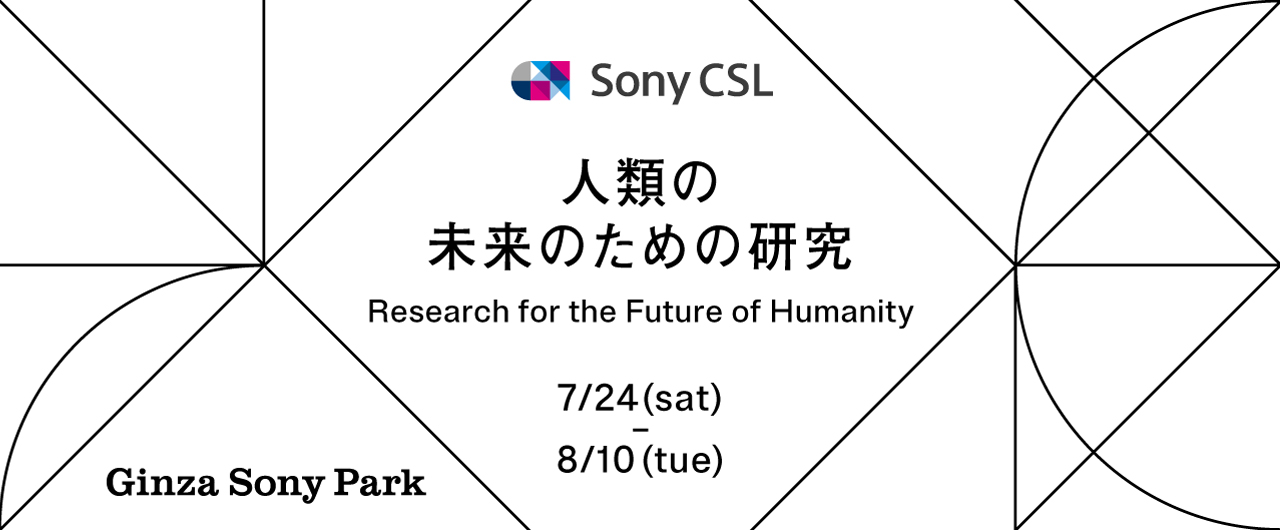

Consider future society through Sony CSL's global agendas and research on the expansion of human ability
An exhibition on seven topics, including displays on Synecoculture™, space optical communications, renewable energy, and robotic artificial legs as well as a hands-on demonstration of Superception
At Sony CSL, researchers set their own individual goals to conduct studies to fulfill the company's purpose, which company head Hiroaki Kitano declares is "doing research for the future of humanity," striving to change the world with their results.
This exhibition introduces research content from among these studies
on themes of global agendas dealing with the global environment and societal problems, such as food, the environment, and energy as well as expanding human ability (human augmentation/creativity). Topics include augmented ecosystems such as Synecoculture™, which expands the diversity and functions of ecosystems through human involvement; a replica of the actual Small Optical Link for International Space Station (SOLISS) carrying out experiments at the Interational Space Station; an Open Energy System that stably provides renewable energy; artificial legs for competition that aim for users to break records set by able-bodied people; and the "Morphing Identity" experience that transforms your face into someone else's imperceptibly.
This event is a chance to come freely into contact with a variety of research in an environment available exclusively at Ginza Sony Park. Why not give some thought to big issues and the bright future of humanity, including the global environment, societal problems, diversity, and SDGs, at this time when we perceive significant changes to the natural environment and such topics are gaining attention worldwide, right in the heart of Tokyo?
Duration:2021.7.24 - 8.10
Location: PARK B3 / Basement 3
#sonycsl #sonypark展
* This program has finished.
Ginza Sony Park will welcome Sony Computer Science Laboratories (Sony CSL), a unique collective of researchers, to hold an exhibition of research presentations using the open space in the streets of the Park.
Sony CSL is a laboratory where researchers set their own individual goals to conduct studies for the future of humanity, striving to change the world with their results.
Experience the researchers' distinctive viewpoints and the possibilities of imagination through the latest research content introduced in this event, with topics from various studies such as global agendas dealing with societal problems like food, the environment, and energy as well as expanding human ability (human augmentation/creativity).
Believe that the future is not something to predict
but something to create ourselves.
Ginza Sony Park
Research opens up the future. And so this future first exists in the imaginations of researchers. Sony Computer Science Laboratories(Sony CSL)ʼ s support of researchers with extraordinary imaginations is what makes it a place that is helping to create a future beyond most of our wildest dreams.
We declare that we conduct research for the future of humanity. Humankind has astonishing potential and great diversity. Bringing out peopleʼs maximum creativity, intellectual power, and physical capabilities, and then using technology to go even further, is how we will continue to unlock humanityʼs potential.
Humanity has this great potential, but it is also confronting exceedingly difficult problems related to the environment, poverty, aging, food, health, medicine and more. These problems are complicated as well as diverse—we are going up against an extremely harsh reality. In order to solve these problems, I believe we will need entirely new ideas that go beyond borders, and exceptionally effective ways of putting these ideas into practice.
We feel it is our duty to solve problems, open up new possibilities, and offer something to the world. And crucial to this is the imagination and drive of our individual researchers. In a sense, you could say that each of our researchers is battling the very limits of his or her imagination.
People have asked us if these wild ideas of ours will ever come true. Can we imagine the things that will happen, and the things that will be needing to be achieved, in as much concrete detail as we can? Do we have the ability to actually make those things happen? Our picture of the future determines the actions we take today.
For this event, we are exhibiting seven topics from our activities. We would be delighted for you to experience the possibilities for the future of humanity and society through everyone's research and projects.
Sony Computer Science Laboratories
President and CEO Hiroaki Kitano
- ALL
- Globalagendas
- Expandinghuman ability
- Workshop
Exhibition Content
Ginza Sony Park will hold the "Research for the Future of Humanity" exhibition displaying research from Sony CSL as an event themed for technology and design supporting Sony, which continues to change in a variety of ways. Of the latest studies by researchers, the event will mainly introduce those on global agendas and expanding human ability.
Global Agendas Dealing with Societal Problems Such as Food, the Environment, and Energy
Global agendas are one of the significant areas of study in which Sony CSL engages. We will introduce three topics from the field of how to approach global environment problems and significant issues on a global scale.
・The Syneco Portal: A Gateway to Augmented Ecosystems, Starting with Synecoculture™, by Masatoshi Funabashi
More than being synonymous with environmental destruction, humans are also beings that can build nature. The past 10 years of research on Synecoculture™ have shown that human intervention can expand the diversity and functions of ecosystems.
This exhibited Syneco Portal creates a small augmented ecosystem, lets visitors experience interaction with the surrounding environment, and is an entryway to learning. This small ecosystem has been designed as an opportunity for anyone to deepen a way of life rooted in the richness of ecosystems by connecting with the surrounding green space, wind, rain, light, different portals in other places, and people they have not seen before.
- Synecoculture contributes to the accomplishment of 11 of the 17 goals in the SDGs.
- "Kyosei noho" (Japanese for "Synecoculture") is a trademark and registered trademark of Sakura Shizen Juku (Co., Ltd.). "Synecoculture" is a trademark of Sony Group Corporation.
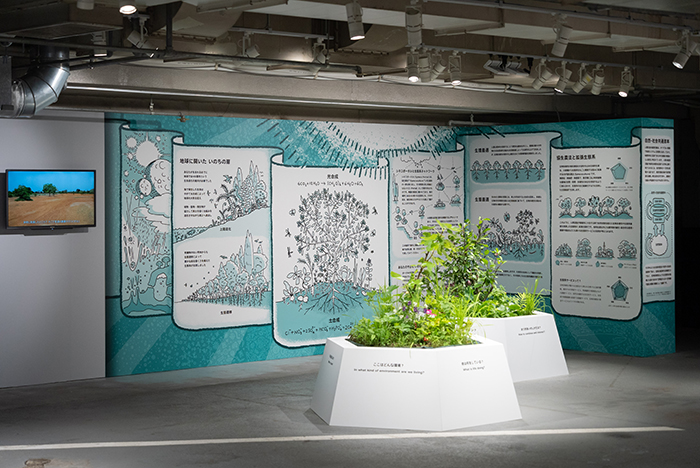
Syneco Portal
・Space Optical Communications Using Optical Disk Technology: The SOL Project
Significant expectations have been placed on satellite transmission to make communications possible in areas where an internet environment has not been sufficiently established and support a real-time information society.
The SOL Project is conducting research and development into an optical communications system that would be installed on small satellites to transmit large volumes of data over long distances. A replica of the actual Small Optical Link for International Space Station (SOLISS) currently installed on the Japanese Experiment Module "Kibo" on the International Space Station to carry out experiments in optical communications will be on display at the venue.
The establishment of long-distance optical communications technology might change the world significantly, such as by expanding the sphere of human existence to space in the future.
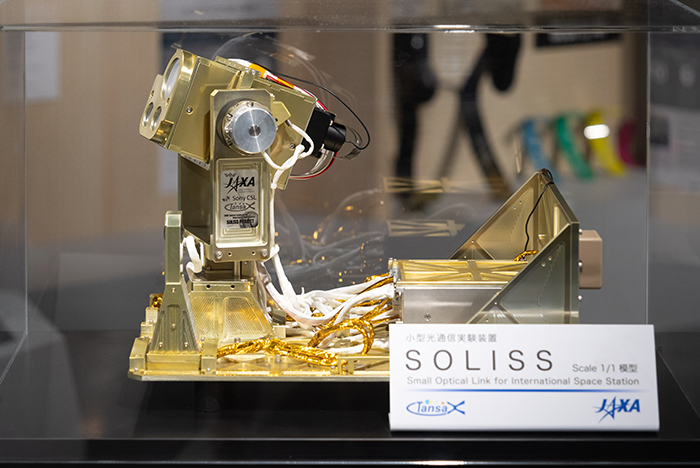
A replica of the actual Small Optical Link for International Space Station
・An Open Energy System: The OES Project
A system promoting the introduction of renewable energy and decentralization of electric power systems
Electric systems in modern society have numerous problems, including massive blackouts caused by disasters and rising infrastructure maintenance costs for long-distance transmission. There are also limitations to the amount of renewable energy introduced in previous electric power systems, in which power generation fluctuates because of the weather, although expectations of renewable energy will increase due to global warming and the growing risk of resource exhaustion.
The OES Project, which will host a panel display for this event, made possible the realization of a decentralized electric power platform system that exchanges renewable energy within a community and utilizes renewable energy stably for local production for local consumption, thanks to power-interchange software equipped with technology developed in the project itself.
The Project is now building a demonstration system centered at Umaba School Cottage, a work-and-leisure facility in Miyoshi, Tokushima, with the goal of an ideal energy society that stably supplies renewable energy with a disaster-resistant infrastructure and securely offers clean electric power to people around the world.
- The OES contributes to the accomplishment of seven of the 17 goals in the SDGs.
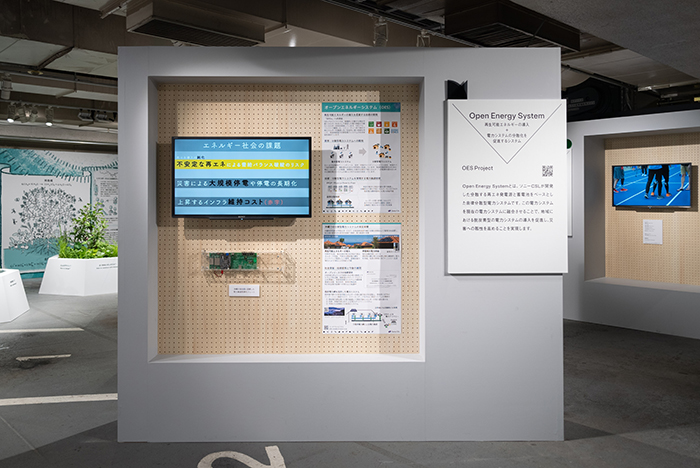
Expanding Human Ability: Human Augumentation/Creativity
This exhibit introduces three topics from the research field of human augmentation, which expands faculties such as physical ability, perception, intuition, and creativity using technology like sensors and AI to defy human potential.
・Human n + Technology = Human n+1, by Ken Endo
Human_(n) + Technology = Human_(n+1), by Ken Endo
This exhibit introduces a project on artificial legs worked on by former bipedal robot researcher Ken Endo.
If, even without legs, people could walk and run normally using technology that moves like legs, perhaps not having legs would not be a disability. Items on display will include the real robotic artificial legs actually used in the OTOTAKE PROJECT, which aims for evolution of the human body through robotics along with Hirotada Ototake, author of No One's Perfect.
Visitors will also see artificial legs for competition that came forth through application of the knowledge gained in research and development of robotic artificial legs. If athletes with artificial legs for competition could run at record speeds faster than able-bodied people, the way of understanding people with disabilities would change.
Technology might merely remove disabilities, or it might become a way of augmenting intrinsic human abilities in themselves. Would you like to imagine a future in which all of us diversify and can go forth in pursuit of our own happiness?
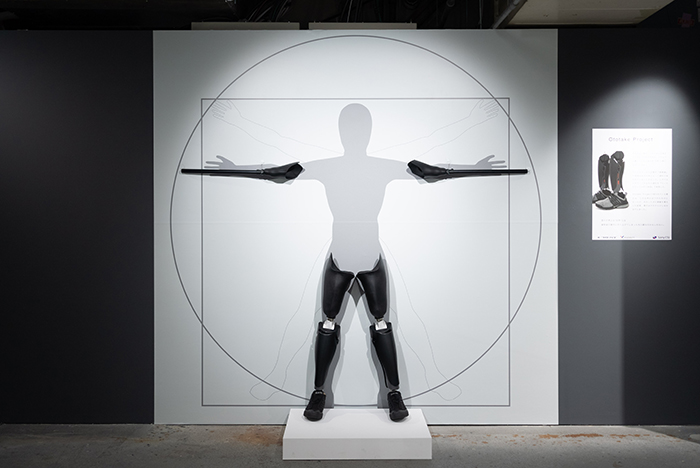
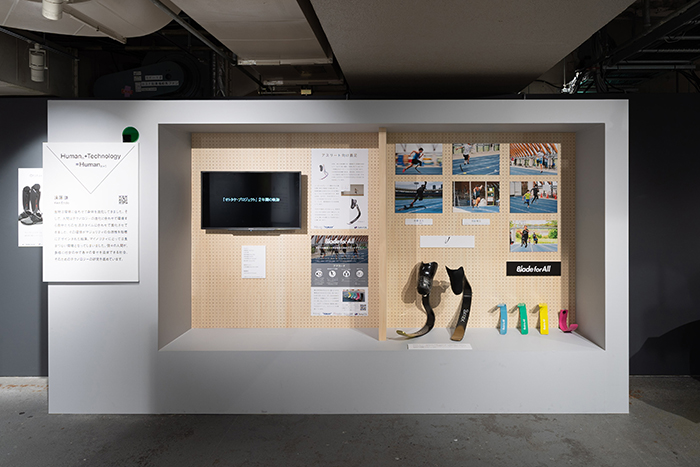
・Theory of Play, by Alexis André
toio™ is a robot toy from Sony Interactive Entertainment that allows users to enjoy free play by installing whatever they like on a small cube.
Sensors scan the cube's position and orientation, and the cube operates based on configured rules. The robot toy toio leads children to all kinds of ingenuity with these simple concepts. It is also a product that makes it easy for children to study programming at home.
Researcher Alexis André, who proposed the initial concept for toio and is also known as "Dr. toio," will combine toio with everyday items to unveil creativity-expanding media art focused on "drawing" play.
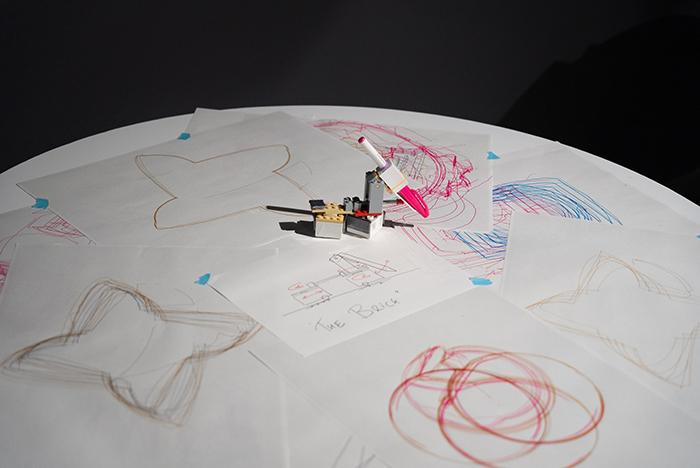
・Superception, by Shunichi Kasahara
This exhibit features one of the Superception research projects, "Morphing Identity." Superception is a research framework that engineers, augments, and transforms perception and cognition with engineering by using computer technologies to intervene in the human senses and connect to human perception.
This hands-on work explores how the self that you think you are and the self that others think you are can be transformed. Images projected by cameras in two booths show the movements of both your body and another person's. Before long, your face gradually fuses with the face of the other person. Based on the human perceptual characteristics of visual changes, computationally created, smooth changes are applied to the facial images and composited in real-time, causing the faces to change without you perceiving the change.
The exhibit approaches human identity through the experience of imperceptibly transforming the face you were sure was your own into the face of another.

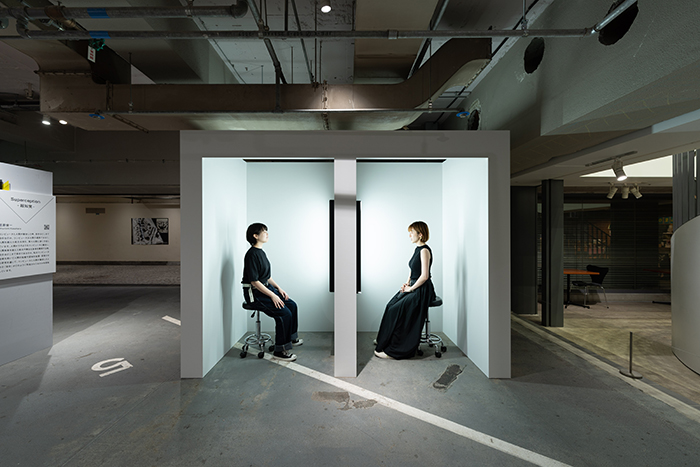

A Laboratory Focused on Values
Sony CSL, based in Tokyo and with a branch office in Paris, opened the Kyoto Laboratory, its first branch office in Japan, in April 2020. The Kyoto Laboratory conducts research on the fulfilment of human values, guided by the understanding that, amid the evolution of technology, a future with an even higher quality of life is possible, going beyond financial and material satisfaction.
・What Is a "Rich" Future?" by the Kyoto Laboratory
The hands-on "What is a 'Rich' Future?" exhibit asks visitors to the Park to share their own thoughts about questions written on the wall.
What kind of future did you envision after seeing several "Research for Future of Humanity" projects on global agendas and human augmentation? How about leaving a brief comment on a sticky note?
The exhibit content lets visitors think about the real meaning of "richness" and their relationships with the people around them in this current age in which efficiency and automation provide convenience and benefit to people's lives.

Workshop for Children
Sony Global Education and the Kids "Power" Project
This is a collaborative project between Sony Global Education (SGED) and the Kids "Power" Project, which operates with the goals of cultivating childrens' zest for life through encounters and connections as well as implementing the skills children naturally have in society.
A workshop for elementary school students will be held on the topic "Making Play: Turning Cleaning into Fun" (provisional). What is the idea process for researcher Alexis André, the originator of new games including toio? The workshop lets children vicariously experience viewpoints that conceive of fun things, with content designed by SGED's education evangelist Akihiro Shimizu and researcher André taking the stage.
Children will consider why games like tag, freeze tag, and red light, green light are fun. Based on their realizations and discoveries, they will think of how to make things they dislike or find bothersome fun. They will present the games they made to everyone, share points of difficulty, and be aware of different perspectives and opinions. The content will raise children's interest in STEAM education.

Event Outline
| Dates and times |
2021.8.7 (Sat)/8.14 (Sat)/8.28 (Sat), 14:00-17:00 |
|---|---|
| Location |
The entire program will be held online. |
| For |
third to sixth year elementary school students and their parents or guardians;people who can participate all three days |
| Quota |
10 groups |
| Application period |
2021.7.15 (Thu)-7.29 (Thu) |
| Application website | https://www.sonyged.com/ja/2021/07/15/events-ja/kids-power-project-2/ |
- There will be a lottery if there are a large number of applications. Lottery results will be sent to registered email addresses on July 30 (Fri).
- See the application website for details.
About Sony Computer Science Laboratories
Sony Computer Science Laboratories (Sony CSL) was founded in February 1988 with the goals of creating new research areas and paradigms as well as new technologies and businesses and contributing to humanity and society.
At Sony CSL, researchers set their own individual goals to conduct research grounded on the company's fundamental research topics. All researchers then present the results of their research under their own names. This is because Sony CSL believes that research is by its nature carried out voluntarily by groups originating from individuals and individual free will and that a laboratory should devote itself to being a presence supporting that.
Sony CSL initially launched its research activities with a focus on topics that uphold the foundation of computer systems, such as distributed operating systems and computer networks. It then expanded its research areas to systems biology, econophysics, and artificial intelligence. Furthermore, its main research topics are now global agendas dealing with societal problems such as agriculture, urban planning, and energy; expanding human ability (human augmentation/creativity); and cybernetic intelligence striving to make real-world systems and processes more intelligent on the foundation of AI and data analysis.
The Kyoto Laboratory was newly founded as the company's third location, after Tokyo and Paris, in 2020, and aims to create even greater value.
https://www.sonycsl.co.jp/
Sony Park Exhibition "Research for the Future of Humanity" Overview
| Duration |
2021.7.24 (Sat)-8.10 (Tue), 11:00-19:00 * This program has finished. |
|---|---|
| Location |
PARK B3/Basement 3 |
| Cost |
free admission (no advance reservation needed/limited number of people) |
| Hashtags |
#sonycsl #sonypark展 |
- Admission to some other events held at the same time is by advance reservation. Please check the Sony Park Exhibition special website.
- Exhibition content and open dates and times may unavoidably be subject to change due to
circumstances such as the issuance of a state of emergency. We ask for your understanding in advance.


![[Instagram] Sony CSL’s public exhibition of research: Sony Park Exhibition “Research for the Future of Humanity.” A display of an artificial legs for competition](/img/common/instagram_2.png)